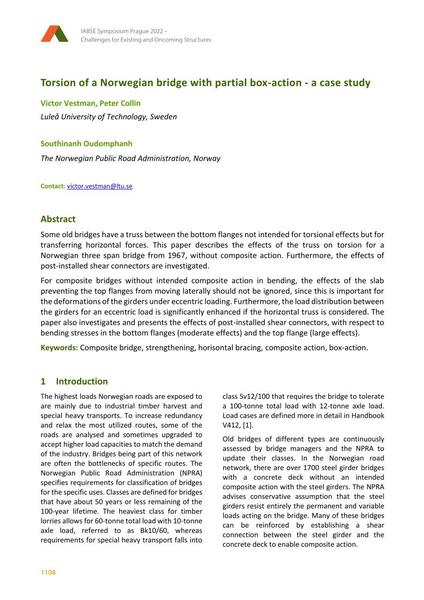Torsion of a Norwegian bridge with partial box-action - a case study

|
|
|||||||||||
Bibliographic Details
| Author(s): |
Victor Vestman
(Luleå University of Technology, Sweden)
Peter Collin (Luleå University of Technology, Sweden) Southinanh Oudomphanh (The Norwegian Public Road Administration, Norway) |
||||
|---|---|---|---|---|---|
| Medium: | conference paper | ||||
| Language(s): | English | ||||
| Conference: | IABSE Symposium: Challenges for Existing and Oncoming Structures, Prague, Czech Republic, 25-27 May 2022 | ||||
| Published in: | IABSE Symposium Prague 2022 | ||||
|
|||||
| Page(s): | 1108-1114 | ||||
| Total no. of pages: | 7 | ||||
| DOI: | 10.2749/prague.2022.1108 | ||||
| Abstract: |
Some old bridges have a truss between the bottom flanges not intended for torsional effects but for transferring horizontal forces. This paper describes the effects of the truss on torsion for a Norwegian three span bridge from 1967, without composite action. Furthermore, the effects of post-installed shear connectors are investigated. For composite bridges without intended composite action in bending, the effects of the slab preventing the top flanges from moving laterally should not be ignored, since this is important for the deformations of the girders under eccentric loading. Furthermore, the load distribution between the girders for an eccentric load is significantly enhanced if the horizontal truss is considered. The paper also investigates and presents the effects of post-installed shear connectors, with respect to bending stresses in the bottom flanges (moderate effects) and the top flange (large effects). |
||||
| Keywords: |
composite bridge strengthening composite action horisontal bracing box-action
|
||||
| Copyright: | © 2022 International Association for Bridge and Structural Engineering (IABSE) | ||||
| License: | This creative work is copyrighted material and may not be used without explicit approval by the author and/or copyright owner. |
||||
